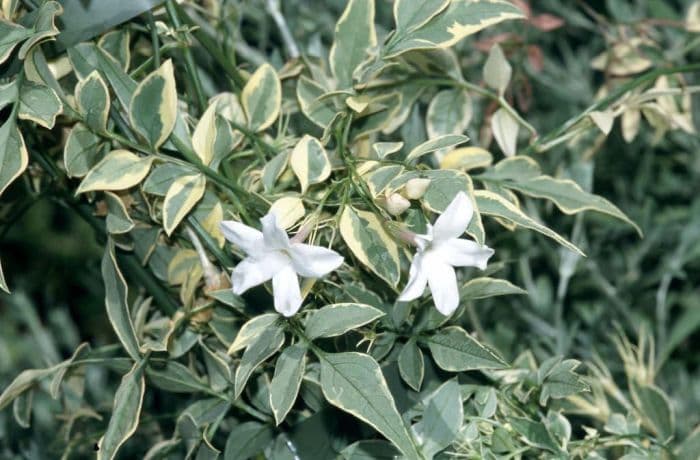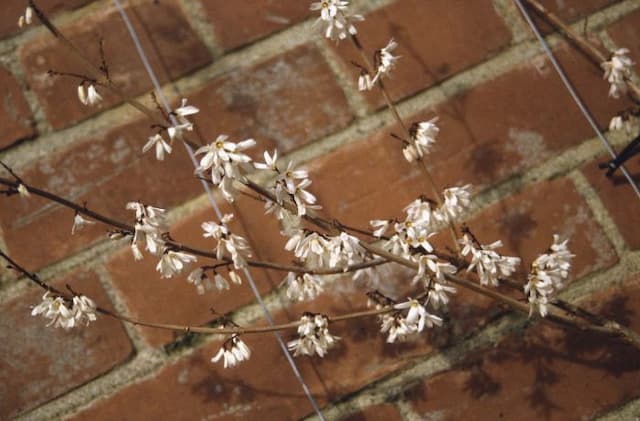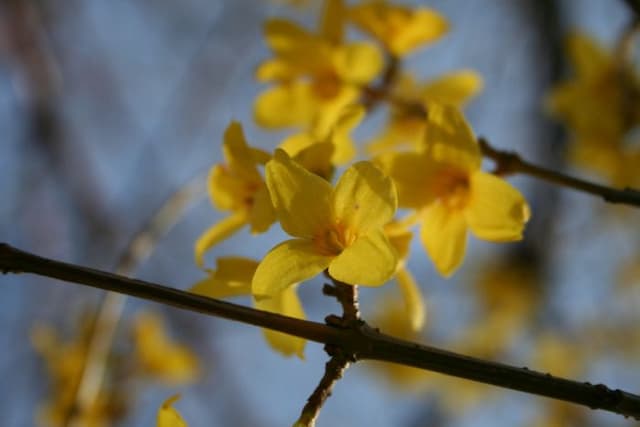Variegated Common Jasmine Jasminum officinale 'Argenteovariegatum' (v)

ABOUT
The plant known as variegated jasmine features a blend of green and white on its leaves, giving it a distinct and attractive variegation. The leaves are typically elongated and display a mix of colors which include different shades of green intermingled with creamy white or sometimes even pure white areas. This marbled pattern adds a decorative element to the foliage. The flowers of this plant are its most notable characteristic; they are small, star-shaped, and exquisitely fragrant. These flowers are usually a pure white color and they bloom in clusters, adding to the visual appeal of the plant. When in bloom, the variegated jasmine becomes a focal point in any garden due to its intensely fragrant flowers and beautifully patterned foliage. The plant exhibits a twining growth habit, meaning it will climb and wrap around structures if given support, or it can sprawl as a ground cover if left to grow on its own.
About this plant
 Names
NamesFamily
Oleaceae
Synonyms
Variegated Poet's Jasmine, Harlequin Jasmine, Silver Variegated Jasmine
Common names
Jasminum officinale var. argenteovariegatum.
 Toxicity
ToxicityTo humans
Common jasmine is not considered toxic to humans. Generally, it doesn’t cause poisoning when touched or ingested, and it is safe when used in the traditional manner, such as in the infusion of tea. However, as with any plant, individual allergies or sensitivities could cause reactions in certain people. If an individual were to have a sensitivity and ingest parts of this plant, they could potentially experience mild stomach irritation or discomfort. Always practice caution and consult with a healthcare professional if you have specific concerns about plant ingestion or if any adverse reactions occur.
To pets
Common jasmine is also generally considered non-toxic to pets. It is not listed among the plants commonly known to be poisonous to pets, such as cats and dogs, so ingestion of this plant should not cause serious harm. However, ingestion of any plant material may cause gastrointestinal upset, such as vomiting or diarrhea, in some pets due to the irritation from the plant or from their digestive system not being accustomed to processing plant material. If your pet ingests this plant and displays such symptoms, it would be wise to consult a veterinarian to ensure they receive proper care.
 Characteristics
CharacteristicsLife cycle
Perennials
Foliage type
Deciduous
Color of leaves
Variegated
Flower color
White
Height
10 feet (3 meters)
Spread
8 feet (2.4 meters)
Plant type
Climber
Hardiness zones
7
Native area
Caucasus
Benefits
 General Benefits
General Benefits- Aesthetic Appeal: The plant exhibits variegated foliage and fragrant white flowers, adding visual interest to gardens and landscapes.
- Attracts Wildlife: It is known to attract pollinators such as bees and butterflies, which are beneficial for plant biodiversity and ecosystem health.
- Privacy Screen: It can be grown as a hedge or screen, which provides privacy and reduces noise pollution.
- Versatility: This plant can be used in a variety of garden settings, including borders, as a climber on trellises, or in containers.
- Low Maintenance: It requires minimal care once established, making it suitable for gardeners of all experience levels.
- Tolerance to Different Conditions: It is adaptable to a range of soil types and can tolerate partial shade, increasing its suitability for various garden locations.
 Medical Properties
Medical Properties- Antispasmodic: Jasmine may help alleviate spasms and cramps in the body.
- Antiseptic: The plant has been traditionally used for its antiseptic properties to help prevent infections.
- Aphrodisiac: Jasmine is often cited as having aphrodisiac properties, potentially increasing sexual desire.
- Aromatherapy: Jasmine oil is used in aromatherapy for relaxation and to reduce anxiety or depression.
- Anti-inflammatory: Some compounds in jasmine have demonstrated anti-inflammatory effects in non-clinical studies.
- Sedative: The essential oil of jasmine may have a sedative effect, promoting relaxation and potentially aiding sleep.
- Analgesic: There is some evidence to suggest that jasmine can help reduce pain when used in aromatherapy or applied topically.
 Air-purifying Qualities
Air-purifying QualitiesThis plant is not specifically known for air purifying qualities.
 Other Uses
Other Uses- As a natural dye: The flowers of Jasminum officinale, commonly known as common jasmine, can be used to create a natural yellow dye for fabrics and handicrafts.
- Perfumed sachets: Dried jasmine flowers can be placed in small sachets to freshen up drawers and closets with their sweet fragrance.
- Bath soak: Fresh jasmine flowers can be added to bathwater to create a fragrant and relaxing soak.
- Flavouring agent: Jasmine flowers can be used to subtly flavor and scent tea blends, desserts, and syrups with its distinct aroma.
- Aromatherapy: Jasmine essential oil, derived from the flowers, is used in diffusers and oil blends for its soothing and calming properties.
- Candle making: The scent of jasmine is often incorporated into candles for its long-lasting and potent fragrance.
- Garden design: The variegated leaves of the 'Argenteovariegatum' variety are used in ornamental garden design for their aesthetic appeal.
- Privacy screens: The climbing nature of the jasmine plant makes it ideal for creating natural, fragrant privacy screens on arbors and fences.
- Culinary garnish: The non-toxic flowers can also serve as an elegant edible garnish on cakes, pastries, and other desserts.
- Wedding decor: Jasmine flowers are often included in wedding bouquets and decorations for their beauty and symbolization of love and purity.
Interesting Facts
 Feng Shui
Feng ShuiVariegated Jasmine is not used in Feng Shui practice.
 Zodiac Sign Compitability
Zodiac Sign CompitabilityVariegated Jasmine is not used in astrology practice.
 Plant Symbolism
Plant Symbolism- Purity: The white flowers of Jasminum officinale, commonly known as common jasmine, often represent purity and innocence due to their bright, unblemished appearance.
- Love: Common jasmine has long been associated with romantic love and is used in many cultures to adorn weddings and ceremonies to celebrate love and affection.
- Beauty: Due to its delicate, attractive flowers and pleasant fragrance, common jasmine symbolizes beauty and is often connected to notions of elegance and grace.
- Sensuality: The intoxicating scent of jasmine is tied to sensuality and is frequently utilized in perfumes to evoke an alluring and sensual aura.
- Good Luck: In some cultures, common jasmine is kept as a symbol of good luck and is believed to bring prosperity and positive energy to a home or garden.
- Night and the Moon: Since many jasmine species, including the common jasmine, are nocturnally fragrant (most potent at night), they are symbolically linked to the mysterious energy of the moon and the serenity of night.
 Water
WaterVariegated jasmine requires regular watering to keep the soil consistently moist but not soggy, particularly during the growing season. In the absence of rainfall, water this plant deeply once a week, providing about 1 to 1.5 gallons per watering session for an established plant in the ground. Container-grown specimens will require more frequent watering, possibly several times a week, depending on the pot size and environmental conditions, ensuring that excess water is allowed to drain freely to prevent root rot.
 Light
LightVariegated jasmine thrives in full sun to partial shade. The ideal spot for this plant would provide bright, indirect light with some dappled sunlight, particularly in the morning. However, it is essential to protect it from the harsh afternoon sun, especially in hotter climates, to prevent scorching of the delicate variegation on the leaves.
 Temperature
TemperatureVariegated jasmine prefers temperate conditions and performs best in temperatures ranging between 60°F and 75°F. It can tolerate minimum temperatures down to around 20°F but will suffer if exposed to prolonged freezing conditions. This plant enjoys warmer temperatures during its active growth period in spring and summer and cooler temperatures in the winter when it’s in a rest phase.
 Pruning
PruningVariegated jasmine benefits from pruning to maintain its shape, encourage bushier growth, and remove any dead or damaged branches. Prune the plant in the late winter or early spring before the onset of new growth. Cut back overgrown stems, and feel free to trim the plant as necessary throughout the growing season to keep the desired form. Always use clean, sharp pruning tools to make clean cuts.
 Cleaning
CleaningAs needed
 Soil
SoilVariegated Jasmine prefers well-draining soil rich in organic matter with a pH between 6.0 to 7.5. A mix of loam, peat, and coarse sand in equal parts works well to support its growth and flowering.
 Repotting
RepottingVariegated Jasmine should be repotted every 2 to 3 years or when roots become noticeably pot-bound. Use a slightly larger pot to encourage continued growth.
 Humidity & Misting
Humidity & MistingVariegated Jasmine thrives in moderate to high humidity levels, ideally between 40% and 60%. Consistently maintaining this range of humidity will promote healthy foliage and bloom.
 Suitable locations
Suitable locationsIndoor
Provide bright light, moderate water, and support for climbing indoors.
Outdoor
Plant in partial shade, protect from cold, ensure moist, well-drained soil.
Hardiness zone
7-10 USDA
 Life cycle
Life cycleJasminum officinale 'Argenteovariegatum,' commonly known as Variegated Common Jasmine, begins its life cycle with seed germination, which occurs in warm and moist soil conditions. Once the seedling emerges, it enters a vegetative state characterized by rapid growth of the variegated leaves and twining stems. The plant then reaches maturity and starts the flowering phase, typically in the late spring or early summer, producing fragrant white flowers that attract pollinators. After pollination, if conditions are favorable, the flowers develop into small black berries, which are the fruiting stage. These berries contain seeds that can be dispersed by various means, such as animals, leading to the potential colonization of new areas. Throughout its life, the Variegated Common Jasmine can experience cycles of growth and dormancy, particularly in temperate climates where it may become quiescent over winter.
 Propogation
PropogationPropogation time
Spring-Early Summer
The Variegated Jasmine (Jasminum officinale 'Argenteovariegatum') is typically propagated by semi-ripe wood cuttings during the summer months. The most popular method involves taking cuttings that are about 4 to 6 inches (approximately 10 to 15 cm) long from healthy, vigorously growing plants. These cuttings should have several pairs of leaves and are best taken from non-flowering shoots to focus the plant's energy on root development. The base of the cutting is dipped in rooting hormone powder to enhance root growth and then inserted into a pot filled with a mixture of peat and perlite or sand to provide adequate drainage. The pot is then placed in a warm, shaded area and kept moist until roots develop, which can take several weeks. Once the roots are established, the new jasmine plants can be transferred to individual pots and eventually planted out in the garden.

![Forsythia [Marée d'Or]](/_next/image?url=https%3A%2F%2Fplants-admin.emdemapps.com%2Fimages%2Fplants%2F%2Fimages%2F604b5d7568293.png&w=640&q=75)







